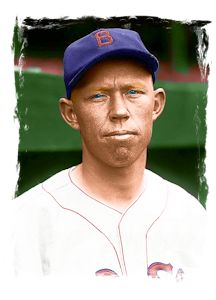 |
Bob Seeds was born on February 24, 1907, in Ringgold, Texas. He played high-school ball at Shamrock-Texola High and also played shortstop for the local semipro teams in Shamrock and Wheeler. On graduation from high school, he had three offers to play pro ball and signed with Oklahoma City who farmed him out. Bob played for two teams in 1926, the year he turned 19, with the Mexia Gushers of the Texas Association and the Enid (Oklahoma) Boosters of the Southwestern League, but didn’t play at all in 1927. He played for the Class-A Western League Amarillo Broncs in 1928, strictly as an outfielder, and hit .340 and was to report to the New Orleans Pelicans in 1929. But he signed with the Cleveland Indians and reported to the AA Kansas City Blues (American Association). The Indians had finished third in 1929 and were hoping to improve on that in 1930. One of the things they needed was a right-handed hitting outfielder and Bob made such a sharp impression on his bosses in spring training, that he became the team’s fourth outfielder. He had a strong season in Cleveland, batting .285 in 85 games. Bob led the Indians in batting during spring training, but he didn’t play as much in 1931. He got into 48 games, batting .306. He played in all of two games for the 1932 Indians, when he was traded to the White Sox in April. He appeared in 116 games and hit a solid .290 for Chicago and was traded to the Boston Red Sox in December. Already by 1933 he was being called “Suitcase”. He played 32 games in the outfield, but put in even more filling in at first base. All told, he got into 82 games but his hitting was subpar, just .243. Bob started the 1934 season with the Red Sox, but this was a time of considerable turnover since new owner Tom Yawkey bought the club. By February, there were only seven members of the Red Sox who were still with the team from 12 months earlier. When the Red Sox had the opportunity to acquire pitcher Wes Ferrell from the Indians, they sent the Indians two players, including Bob, in May. It seems that ever since Cleveland lost him, they have wanted him back. He’d been a great team factor for morale and a humorist and had plenty of friends in and around the Cleveland ball yard. It wasn’t long into 1935 before "Suitcase" Seeds had a new team. In January he was purchased by the Detroit Tigers, but spent the entire season in the International League, playing in 144 games for the Montreal Royals. The New York Yankees, beset by injuries, acquired him in August and he played in 13 games for the Yankees. For the first time he was with a club that won the pennant and was on the roster for the 1936 World Series. Bob was in the Yankees’ system now and was optioned to their Newark Bears in January 1937. In 59 games with Newark in 1938, he hit .335 with 28 homers, which really attracted attention. In June, the New York Giants had to replace the injured Jo-Jo Moore and purchased him from the Yankees. He was brought back for the next two seasons, though he didn’t play as much in those full seasons as he had, while filling in during his half-season of 1938. He played in 56 games in 1940, with four homers and 16 RBIs. He was mailed a contract for 1941, but was sold to the Baltimore Orioles before the season began. His big-league days were over and he finished with a lifetime .277 average. It was a disappointing year in 1941, playing at Double A and batting .264. He started the season with Baltimore again in 1942, but was given his unconditional release in May, batting .143. The Indianapolis Indians picked him up and hit .269 in 66 games. In 1943 he signed to manage the Oklahoma City Indians, the team where he had started. It was a short first stint as manager. Before he had a chance to run the club for even one game, the Texas League folded. In 1944, Bob did manage. He was a player/manager for Little Rock, but managing perhaps did not agree with him, so he resigned his position after the season. In 1945, though he was expected to play outfield again, he stayed home, by his own choice, announcing that he would be managing his sporting goods store and playing semipro baseball. Postwar, Bob took one more position, as manager of the Amarillo Gold Sox (Class-C West Texas-New Mexico League). In 1943, he and his wife owned the Amarillo ball club at that time. He sold the club in February 1950, but remained as general manager. Bob settled down to life as a rancher, feeding and caring for hogs and cattle. The name of his ranch was Bob Seeds Hog Farm. In 1961, he was inducted into the Panhandle Sports Hall of Fame and died on October 28, 1993, at the Erick Nursing Center, in Erick, Oklahoma, at age 83. |
|||||
